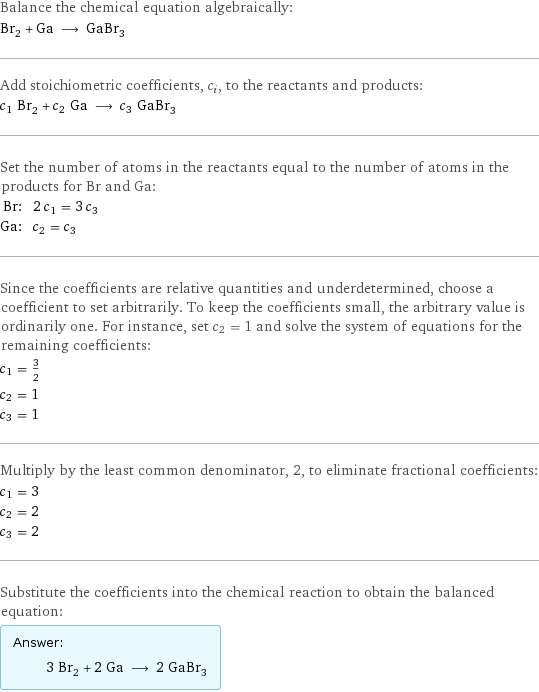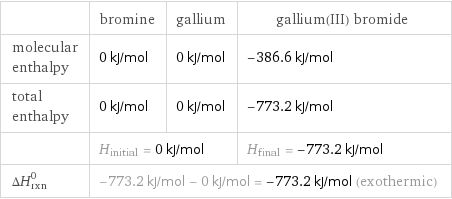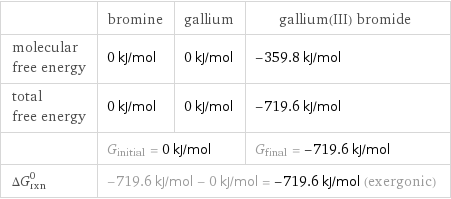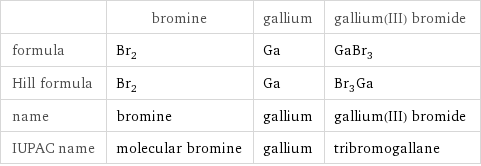Input interpretation

Br_2 bromine + Ga gallium ⟶ GaBr_3 gallium(III) bromide
Balanced equation

Balance the chemical equation algebraically: Br_2 + Ga ⟶ GaBr_3 Add stoichiometric coefficients, c_i, to the reactants and products: c_1 Br_2 + c_2 Ga ⟶ c_3 GaBr_3 Set the number of atoms in the reactants equal to the number of atoms in the products for Br and Ga: Br: | 2 c_1 = 3 c_3 Ga: | c_2 = c_3 Since the coefficients are relative quantities and underdetermined, choose a coefficient to set arbitrarily. To keep the coefficients small, the arbitrary value is ordinarily one. For instance, set c_2 = 1 and solve the system of equations for the remaining coefficients: c_1 = 3/2 c_2 = 1 c_3 = 1 Multiply by the least common denominator, 2, to eliminate fractional coefficients: c_1 = 3 c_2 = 2 c_3 = 2 Substitute the coefficients into the chemical reaction to obtain the balanced equation: Answer: | | 3 Br_2 + 2 Ga ⟶ 2 GaBr_3
Structures

+ ⟶
Names

bromine + gallium ⟶ gallium(III) bromide
Reaction thermodynamics
Enthalpy

| bromine | gallium | gallium(III) bromide molecular enthalpy | 0 kJ/mol | 0 kJ/mol | -386.6 kJ/mol total enthalpy | 0 kJ/mol | 0 kJ/mol | -773.2 kJ/mol | H_initial = 0 kJ/mol | | H_final = -773.2 kJ/mol ΔH_rxn^0 | -773.2 kJ/mol - 0 kJ/mol = -773.2 kJ/mol (exothermic) | |
Gibbs free energy

| bromine | gallium | gallium(III) bromide molecular free energy | 0 kJ/mol | 0 kJ/mol | -359.8 kJ/mol total free energy | 0 kJ/mol | 0 kJ/mol | -719.6 kJ/mol | G_initial = 0 kJ/mol | | G_final = -719.6 kJ/mol ΔG_rxn^0 | -719.6 kJ/mol - 0 kJ/mol = -719.6 kJ/mol (exergonic) | |
Equilibrium constant
![Construct the equilibrium constant, K, expression for: Br_2 + Ga ⟶ GaBr_3 Plan: • Balance the chemical equation. • Determine the stoichiometric numbers. • Assemble the activity expression for each chemical species. • Use the activity expressions to build the equilibrium constant expression. Write the balanced chemical equation: 3 Br_2 + 2 Ga ⟶ 2 GaBr_3 Assign stoichiometric numbers, ν_i, using the stoichiometric coefficients, c_i, from the balanced chemical equation in the following manner: ν_i = -c_i for reactants and ν_i = c_i for products: chemical species | c_i | ν_i Br_2 | 3 | -3 Ga | 2 | -2 GaBr_3 | 2 | 2 Assemble the activity expressions accounting for the state of matter and ν_i: chemical species | c_i | ν_i | activity expression Br_2 | 3 | -3 | ([Br2])^(-3) Ga | 2 | -2 | ([Ga])^(-2) GaBr_3 | 2 | 2 | ([GaBr3])^2 The equilibrium constant symbol in the concentration basis is: K_c Mulitply the activity expressions to arrive at the K_c expression: Answer: | | K_c = ([Br2])^(-3) ([Ga])^(-2) ([GaBr3])^2 = ([GaBr3])^2/(([Br2])^3 ([Ga])^2)](../image_source/170887b6f28e305302c7bac96e8e7f79.png)
Construct the equilibrium constant, K, expression for: Br_2 + Ga ⟶ GaBr_3 Plan: • Balance the chemical equation. • Determine the stoichiometric numbers. • Assemble the activity expression for each chemical species. • Use the activity expressions to build the equilibrium constant expression. Write the balanced chemical equation: 3 Br_2 + 2 Ga ⟶ 2 GaBr_3 Assign stoichiometric numbers, ν_i, using the stoichiometric coefficients, c_i, from the balanced chemical equation in the following manner: ν_i = -c_i for reactants and ν_i = c_i for products: chemical species | c_i | ν_i Br_2 | 3 | -3 Ga | 2 | -2 GaBr_3 | 2 | 2 Assemble the activity expressions accounting for the state of matter and ν_i: chemical species | c_i | ν_i | activity expression Br_2 | 3 | -3 | ([Br2])^(-3) Ga | 2 | -2 | ([Ga])^(-2) GaBr_3 | 2 | 2 | ([GaBr3])^2 The equilibrium constant symbol in the concentration basis is: K_c Mulitply the activity expressions to arrive at the K_c expression: Answer: | | K_c = ([Br2])^(-3) ([Ga])^(-2) ([GaBr3])^2 = ([GaBr3])^2/(([Br2])^3 ([Ga])^2)
Rate of reaction
![Construct the rate of reaction expression for: Br_2 + Ga ⟶ GaBr_3 Plan: • Balance the chemical equation. • Determine the stoichiometric numbers. • Assemble the rate term for each chemical species. • Write the rate of reaction expression. Write the balanced chemical equation: 3 Br_2 + 2 Ga ⟶ 2 GaBr_3 Assign stoichiometric numbers, ν_i, using the stoichiometric coefficients, c_i, from the balanced chemical equation in the following manner: ν_i = -c_i for reactants and ν_i = c_i for products: chemical species | c_i | ν_i Br_2 | 3 | -3 Ga | 2 | -2 GaBr_3 | 2 | 2 The rate term for each chemical species, B_i, is 1/ν_i(Δ[B_i])/(Δt) where [B_i] is the amount concentration and t is time: chemical species | c_i | ν_i | rate term Br_2 | 3 | -3 | -1/3 (Δ[Br2])/(Δt) Ga | 2 | -2 | -1/2 (Δ[Ga])/(Δt) GaBr_3 | 2 | 2 | 1/2 (Δ[GaBr3])/(Δt) (for infinitesimal rate of change, replace Δ with d) Set the rate terms equal to each other to arrive at the rate expression: Answer: | | rate = -1/3 (Δ[Br2])/(Δt) = -1/2 (Δ[Ga])/(Δt) = 1/2 (Δ[GaBr3])/(Δt) (assuming constant volume and no accumulation of intermediates or side products)](../image_source/50cf1f3e96800ff7b3c0a018bb0588c2.png)
Construct the rate of reaction expression for: Br_2 + Ga ⟶ GaBr_3 Plan: • Balance the chemical equation. • Determine the stoichiometric numbers. • Assemble the rate term for each chemical species. • Write the rate of reaction expression. Write the balanced chemical equation: 3 Br_2 + 2 Ga ⟶ 2 GaBr_3 Assign stoichiometric numbers, ν_i, using the stoichiometric coefficients, c_i, from the balanced chemical equation in the following manner: ν_i = -c_i for reactants and ν_i = c_i for products: chemical species | c_i | ν_i Br_2 | 3 | -3 Ga | 2 | -2 GaBr_3 | 2 | 2 The rate term for each chemical species, B_i, is 1/ν_i(Δ[B_i])/(Δt) where [B_i] is the amount concentration and t is time: chemical species | c_i | ν_i | rate term Br_2 | 3 | -3 | -1/3 (Δ[Br2])/(Δt) Ga | 2 | -2 | -1/2 (Δ[Ga])/(Δt) GaBr_3 | 2 | 2 | 1/2 (Δ[GaBr3])/(Δt) (for infinitesimal rate of change, replace Δ with d) Set the rate terms equal to each other to arrive at the rate expression: Answer: | | rate = -1/3 (Δ[Br2])/(Δt) = -1/2 (Δ[Ga])/(Δt) = 1/2 (Δ[GaBr3])/(Δt) (assuming constant volume and no accumulation of intermediates or side products)
Chemical names and formulas

| bromine | gallium | gallium(III) bromide formula | Br_2 | Ga | GaBr_3 Hill formula | Br_2 | Ga | Br_3Ga name | bromine | gallium | gallium(III) bromide IUPAC name | molecular bromine | gallium | tribromogallane
Substance properties

| bromine | gallium | gallium(III) bromide molar mass | 159.81 g/mol | 69.723 g/mol | 309.43 g/mol phase | liquid (at STP) | solid (at STP) | solid (at STP) melting point | -7.2 °C | 29.8 °C | 121.5 °C boiling point | 58.8 °C | 2403 °C | 279 °C density | 3.119 g/cm^3 | 5.904 g/cm^3 | 3.69 g/cm^3 solubility in water | insoluble | insoluble | soluble surface tension | 0.0409 N/m | | dynamic viscosity | 9.44×10^-4 Pa s (at 25 °C) | 0.0019 Pa s (at 53 °C) |
Units
